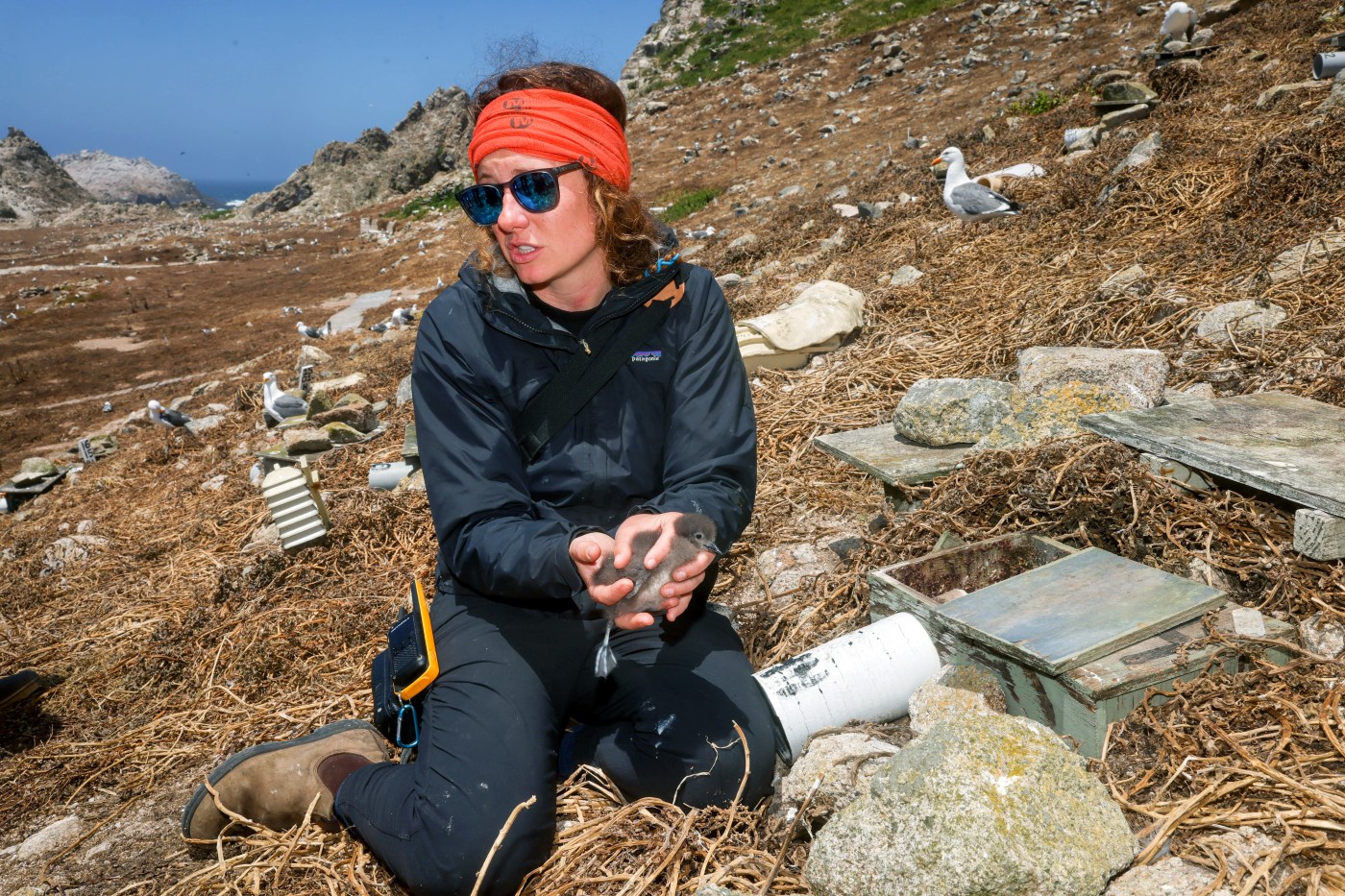The wild and remote Farallon Islands, 27 miles off the coast of San Francisco, offer daily proof of nature’s ebbs and flows.
The changes, unseen by most, are dramatic. California sea lions have moved here from southern California. Whales are cruising by earlier in the spring. Sharks have changed their dining preferences. Seabirds, once nearly gone, are now abundant, filling the air with shrieks, songs and stinky poop perfume.
How do we know this? Because people are counting animals — every day. For 56 years, biologists with the nonprofit Point Blue Conservation Science have braved wind, fog and isolation at the 211-acre National Wildlife Refuge to build a rich wildlife database.
Amanda Spears, Farallon program Biologist with Point Blue Conservation Science, holds a Cassin’s Auklet chick out of a manmade Auklet nest box made to protect them from predators at Farallon Islands National Wildlife Refuge in Farallon Islands, Calif., on Friday, May 31, 2024. Point Blue Conservation Science has done seabird, shark, fish, and other research for more than 50 years at the island, but its partner, U.S. Fish and Wildlife Service, will no longer provide funding to continue research at many national wildlife refuges due to budget tightening. (Ray Chavez/Bay Area News Group)
But now that’s in peril.
Related Articles
California rescue centers concerned by illness, deaths among sea lions as facilities fill
What to do about a San Mateo cat that won’t stop biting his new owner
Swimmer seriously injured in shark attack on California coast
Mountain lion caught on camera roaming Milpitas
Plans to use sharpshooters from copters to kill Catalina Island deer are dropped
Due to budget tightening, the U.S. Fish and Wildlife Service (USFWS) will cease funding Point Blue’s year-round research next year, threatening the continuity of vital ecological data and marine ecosystem management even as climate change provokes ecological shifts.
“The Service is in a constrained budget environment, and we’re working to make judicious use of our resources,” said USFWS’s spokewoman Jackie D’Almeida. The refuge costs about $600,000 a year to operate, and there is a $8 million backlog in deferred maintenance, she said.
The loss means that Point Blue will no longer be able to maintain a year-round presence, so the islands would be unattended in the fall and winter, said Jaime Jahncke, who directs Point Blue’s California Current Group.
Several crucial long-term datasets will be discontinued, he said. There will be smaller scientific teams, so fewer species can be monitored. Not as many young scientists will be trained. And when the islands are unstaffed, they could be damaged by trespassers.
Research by the Petaluma-based Point Blue has led to several key environmental policy reforms, such as the 1987 gill-netting prohibition aimed at protecting seabirds from drowning, the 1993 legal protection of white sharks, and the creation of three California Marine Protected Areas around the islands in 2010. Its findings triggered the removal of invasive cats and rabbits, leading to the recovery of birds called Rhinoceros Auklets.
Its work also informs day-to-day management decisions; for instance, the group’s documentation of whales is used to alert ships, implement speed limits and set dates for crab fishing.
“When monitoring goes away, the ability to make science-based protections also goes away,” said Point Blue spokesman Zachary Warnow.
A colony of Common Murres, the most populous bird on the island with approximately 350,000 individuals, according to Point Blue Conservation Science at Farallon Islands National Wildlife Refuge in Farallon Islands, Calif., on Friday, May 31, 2024. Point Blue Conservation Science has done seabird, shark, fish, and other research for more than 50 years at the island, but its partner, U.S. Fish and Wildlife Service, will no longer provide funding to continue research at many national wildlife refuges due to budget tightening. (Ray Chavez/Bay Area News Group)
A longtime partner of USFWS, Point Blue now will be forced to depend exclusively on private donations from foundations and individuals. They worry that the loss of federal funding will make it harder to secure private donations. The loss of $300,000 in federal funding, which represented about a third of the group’s budget on the islands, helped anchor the research effort.
Saw-toothed crags, the Farallon Islands are uninhabited except for the field research station on Southeast Farallon Island, with no fresh water. About every two weeks, scientists are supplied with food and supplies. Permits to go ashore are rarely granted.
Surrounded by strong cold currents and blooming clouds of krill and fish, the Farallon Refuge has been dubbed “California’s Galapagos” because it shelters a huge range of animal and plant life, including endangered and threatened species. It hosts the largest colony of nesting seabirds in the continental U.S. outside of Alaska.
It’s a world-renowned stopover site for unique vagrant birds, lost or blown off course. Last month, researchers reported the Asian cerulean Blue Rock Thrush, only the second known sighting of the bird in the United States.
On Friday, scientists spotted a rare Nazca Booby, a species that breeds in the Galapagos Islands. The Nazca Booby is very rare this far north, but occurrences are increasing.
A Nazca Booby, a species that breeds in the Galapagos Islands, was seen at Farallon Islands National Wildlife Refuge, Calif., on Friday, May 31, 2024. Sightings of rare vagrant birds are recorded by the nonprofit Point Blue Conservation Science, which has conducted research for more than the 50 years at the Refuge but is losing its federal funding.
After breeding populations of seabirds called Cassin’s Auklets suffered a worrisome decline, Point Blue researchers erected subdivisions of nest boxes, which act as artificial burrows, to monitor individual birds in a controlled way.
“We’re studying occupancy, trying to answer the question: Are the birds in the boxes the same birds that came five or ten years ago?” said Point Blue biologist Amanda Spears.
The Farallon Islands refuge isn’t alone in facing a funding crisis. The entire National Wildlife Refuge System, the nation’s largest network of lands and waters dedicated to wildlife conservation, is reducing essential services.
Rising costs are eating into minor increases in appropriations, causing an effective decline in its budget, according to federal officials. In 2010, the Refuge System received about $765 million in inflation-adjusted dollars ; last year’s budget was $527 million.
Meanwhile, the refuge system has grown. About 18 new refuge units and hundreds of millions of acres of marine national monuments have been added to the nation’s existing 571 refuges, as well as new services, such as the Urban Wildlife Conservation Program.
Without enough money, no national wildlife refuge is fully staffed, and more than half have no staff on-site, so they are closed to the public and completely unmanaged, according to the advocacy group National Wildlife Refuge Association. There aren’t enough law enforcement officers; some officers are covering entire states. Many volunteer programs are being cut back or entirely eliminated due to a lack of supervision from staff.
“Over the past twenty years, the Service’s capacity has eroded significantly, while at the same time costs and workloads have increased, and challenges to wildlife conservation have become more complex,” said Martha Williams, director of USFW, in a budget request to a the House Committee on Natural Resources, Subcommittee on Water, Wildlife, and Fisheries on May 16.
Gulls seat on their nests at Farallon Islands National Wildlife Refuge in Farallon Islands, Calif., on Friday, May 31, 2024. Point Blue Conservation Science has done seabird, shark, fish, and other research for more than 50 years at the island, but its partner, U.S. Fish and Wildlife Service, will no longer provide funding to continue research at many national wildlife refuges due to budget tightening. (Ray Chavez/Bay Area News Group)
“These challenging budgets have required us to pull back on important partnerships and conservation work,” she said.
Farallon Islands National Wildlife Refuge manager Jerry McChesney mourned the potential loss of Point Blue, saying that the nonprofit’s scientists, volunteers and donors have helped prop up the federal effort. While the USFWS has legal responsibility for the refuge at the islands also known as the Farallones, he explained, Point Blue plays the lead role in day-to-day refuge management and research.
“The Farallones are a living laboratory, and you can’t look at the effects of climate change from studying something for just a year or two,” said McChesney. “You have to study it year after year after year — and you can’t stop.”
“The reality,” he said, “is that we couldn’t manage this place without them.”
Amanda Spears, Farallon program Biologist with Point Blue Conservation Science, left, and wildlife refugee manager, Gerry McChesney, look at a gull seated on a nest with its chick and an egg at the top of the Farallon Islands National Wildlife Refuge lighthouse hill in Farallon Islands, Calif., on Friday, May 31, 2024. Point Blue Conservation Science has done seabird, shark, fish and other research for more than 50 years at the island, but its partner, the U.S. Fish and Wildlife Service will no longer provide funding to continue research at many national wildlife refuges due to budget tightening. (Ray Chavez/Bay Area News Group)












